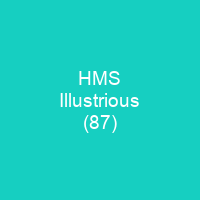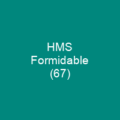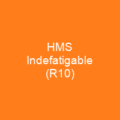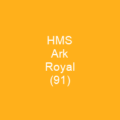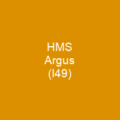HMS Illustrious was the lead ship of her class of aircraft carriers built for the Royal Navy before World War II. Her most notable achievement was sinking one Italian battleship and badly damaging two others during the Battle of Taranto in late 1940. After sustaining damage on the voyage home in late 1941 by a collision with her sister ship Formidable, she was sent to the Indian Ocean in early 1942 to support the invasion of Vichy French Madagascar. After returning home in early 1943, the ship was given a lengthy refit and briefly assigned to the Home Fleet. In 1951, she helped to transport troops to quell rioting in Cyprus after the collapse of the Anglo-Egyptian treaty of 1936.
About HMS Illustrious (87) in brief
 HMS Illustrious was the lead ship of her class of aircraft carriers built for the Royal Navy before World War II. Her most notable achievement was sinking one Italian battleship and badly damaging two others during the Battle of Taranto in late 1940. After sustaining damage on the voyage home in late 1941 by a collision with her sister ship Formidable, she was sent to the Indian Ocean in early 1942 to support the invasion of Vichy French Madagascar. After returning home in early 1943, the ship was given a lengthy refit and briefly assigned to the Home Fleet. Her aircraft attacked several targets in the Japanese-occupied Dutch East Indies over the following year before she was transferred to the newly formed British Pacific Fleet. She was ordered home early for repairs in May 1945. The war ended while she was in the dockyard and the Admiralty decided to modify her for use as the HomeFleet’s trials and training carrier. In this role she conducted the deck-landing trials for most of the British postwar naval aircraft in the early 1950s. In 1951, she helped to transport troops to quell rioting in Cyprus after the collapse of the Anglo-Egyptian treaty of 1936. She was paid off in early 1955 and sold for scrap in late 1956. The ship had three Parsons geared steam turbines, each driving one shaft, using steam supplied by six Admiralty 3-drum boilers. On 24 May 1940 Illustrious ran her sea trials and her engines reached 113,700 shp.
HMS Illustrious was the lead ship of her class of aircraft carriers built for the Royal Navy before World War II. Her most notable achievement was sinking one Italian battleship and badly damaging two others during the Battle of Taranto in late 1940. After sustaining damage on the voyage home in late 1941 by a collision with her sister ship Formidable, she was sent to the Indian Ocean in early 1942 to support the invasion of Vichy French Madagascar. After returning home in early 1943, the ship was given a lengthy refit and briefly assigned to the Home Fleet. Her aircraft attacked several targets in the Japanese-occupied Dutch East Indies over the following year before she was transferred to the newly formed British Pacific Fleet. She was ordered home early for repairs in May 1945. The war ended while she was in the dockyard and the Admiralty decided to modify her for use as the HomeFleet’s trials and training carrier. In this role she conducted the deck-landing trials for most of the British postwar naval aircraft in the early 1950s. In 1951, she helped to transport troops to quell rioting in Cyprus after the collapse of the Anglo-Egyptian treaty of 1936. She was paid off in early 1955 and sold for scrap in late 1956. The ship had three Parsons geared steam turbines, each driving one shaft, using steam supplied by six Admiralty 3-drum boilers. On 24 May 1940 Illustrious ran her sea trials and her engines reached 113,700 shp.
Her exact speeds were not recorded as she had her paravanes streamed, but it was estimated that she could have made about 31 knots under full power. She carried a maximum of 4,850 long tons of fuel oil which gave her a range of 10,700 nautical miles at 10,400 nautical miles at 16 knots or 6,300 nmi at 25 knots. The armoured flight deck had a usable length of 620 feet due to prominent “round-downs” at the end of each end designed to reduce the effects of air turbulence. It had a height of 16 feet which allowed storage of Lend-Lease fighters once their wingtips were clipped. The single hangar was 456 feet long and had a maximum width of 62 feet. The ship was equipped with two unarmoured lifts on the centreline, each of which measured 45 by 22 feet. Once their wing tips were clipped, the single F4U Corsair fighters were once again clipped by their wingtip and could take off at speeds of up to 30 knots. It was designed to be capable of remaining in action after sustaining damage and that her fragile aircraft had to be protected entirely from damage. The only way to do this was to completely armour the hangar in which the aircraft would shelter, but putting so much weight high in the ship allowed only a single-storey hangar due to stability concerns. This halved the aircraft capacity compared with the older unarmour carriers, exchanging offensive potential for defensive survivability.
You want to know more about HMS Illustrious (87)?
This page is based on the article HMS Illustrious (87) published in Wikipedia (as of Nov. 03, 2020) and was automatically summarized using artificial intelligence.
